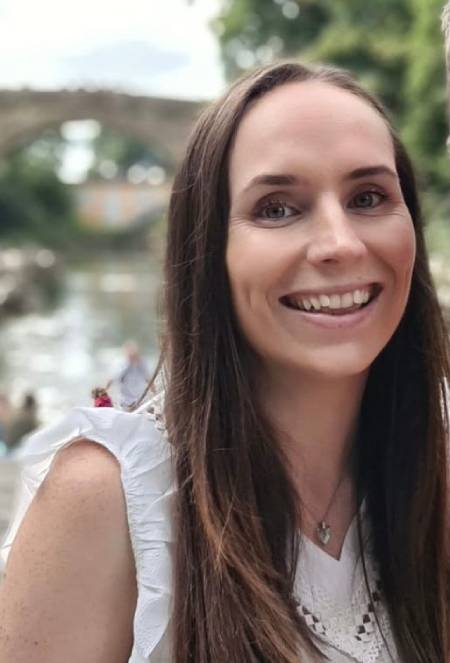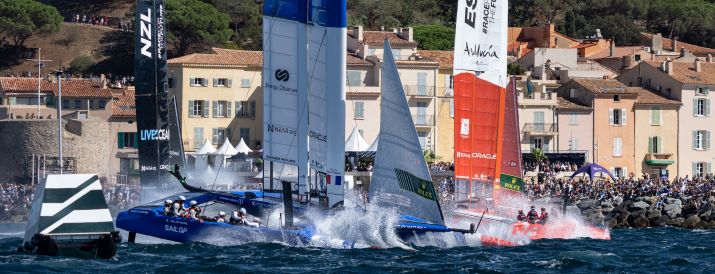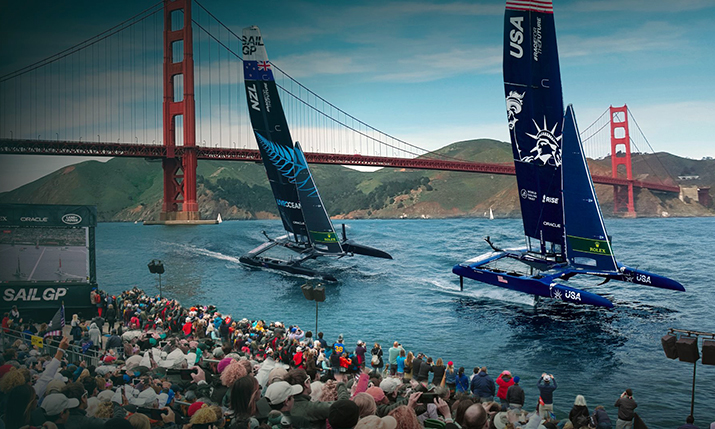Plain sailing: SailGP graphics developer in technology Emma Fox discusses pushing your comfort zone to take you to new levels

SailGP’s graphics developer in technology for LiveLineFX, Emma Fox
SailGP’s graphics developer in technology for LiveLineFX, Emma Fox, has experienced a busy career in graphic design that has ultimately led her to augmenting the fan’s view of the SailGP F50 racing foil. We talk about design, ambition and challenges.
What is your job role today and what do you love about it?
I create graphics for LiveLineFX, SailGP’s augmented reality (AR) graphics product that has transformed how people watch and understand our sport.
The biggest part of my job is creating a 2D graphics package within a software called tog for SailGP which got launched in February. I also create conceptual mock ups and rendered mov files showing how LivelineFX could be featured during broadcast for potential clients and finally creating graphics for sponsors that we use within broadcast.
I love the fact that no day is ever the same. It’s like I constantly have a puzzle to solve and it’s very satisfying when I manage to work it all out. Most of the time you have to think outside of the box!
There’s nothing quite like working in sports broadcasting as everyone seems to bounce off everyone’s energy in the strange hours that you work. Just be ready for last minute adjustments as you’re lucky if everything runs as planned.
We’ve had all sorts of delays, such as dolphins on the course, which obviously changes things quite dramatically!
What draws you to your career in live sport?
The opportunity of professional growth attracted me to live sport which led me into a greater job satisfaction level, as it’s quite intense with last minute changes or new graphic adjustments. However, when you see the graphic on TV, it feels very rewarding as on the weeks of an event it feels like a battle against time trying to get things complete.
I seem to love the thrill of all the challenges that we’re faced with.
What advice would you give to other women looking to move into a role in sports broadcasting like your own?
I would say break every challenge down until it sounds realistic, as some challenges can be quite intimidating if you look at the whole picture.
Always have a “can do” attitude – I feel like this is most important and people are more likely to come to you if you have this mindset.
Always share knowledge and grow together as a team as you’re only as strong as your team is.
Any constructive criticism you get, don’t take it personally, just learn from it.
Finally, If anyone tries to tell you that you’re not good enough… just ignore them!
 How did you first find out about TV broadcasting as a career? What was your inspiration or idea, and why sports broadcasting?
How did you first find out about TV broadcasting as a career? What was your inspiration or idea, and why sports broadcasting?
Long story short, I lived in Los Angeles for two years when I was younger and absolutely fell in love with Disney and Universal. I loved the production side and the backlot tour at Universal just blew my mind. At that point I knew I wanted to do something in that field but at first I thought I wanted to be an animator.
After university I realised I loved the animation side of things but also loved graphic design too. I basically realised that motion graphics is a combination of animations and graphic design. I have been morphing my role ever since and now I’m a graphics developer.
What has been your career path within TV?
My first role was at a company called 1 Media and it involved creating 2D and 3D internal and external videos as well as LED pitch sideboards. Also, communicating with external companies such as Stonegate Pub Company, Lipsy, Coke-Cola, Sports Direct as well as other smaller companies.
I was extremely happy when I got this role but it was a steep learning curve as this was my first role in my career and even though I was fresh out of education, I had so much more to learn and realised I was a small fish within a big pond. I feel like in any job when you first start you want to prove to your employer that you were a good choice, but in order to do that, you always have so much to learn and so much to prove.
I haven’t always been in the sporting industry, I’ve just slowly developed into the industry over time. I started with some work experience at Blackpool illuminations and I was there when Laurence Llewelyn-Bowen was doing his designs back in 2008.
In between some other jobs, in 2016 I went to Liverpool Football Club as a motion graphic designer and then it led me to my current role at SailGP in the LiveLine department as a graphics developer.
It looked like a new challenge which I was ready for in my career. It also allowed me to engage in new tasks and responsibilities and open up for new learning.
 Tell us more about your first job in sports broadcasting.
Tell us more about your first job in sports broadcasting.
In 2016 I applied on Indeed for a job at Liverpool football club as a motion graphic designer. I really didn’t think I was going to get the role as the whole process was about six months. I had three interviews with them and I genuinely thought that I failed the practical exam as I put so much pressure on myself and didn’t feel like I produced my best work.
However, to my disbelief I was offered the position! It was the most varied role that I’ve ever had; I created social graphic content for YouTube, Facebook, Twitter, Instagram and SnapChat, developed worldwide marketing assets to promote LFCTV and GO by creating GIF banners, LED billboards – one of them featuring in New York (one of my highlights in my career) – HTML 5, leaflets and bus designs. Then I created daily television motion graphics for Liverpool Football Club’s national television football channel, and generated videos for worldwide recognised partners and sponsors.
But I wanted to push myself into a more challenging role as I felt comfortable within the role at Liverpool FC, so I needed a change. I kept my eyes peeled for a new job and I saw a job at SailGP on Linkedin. The job description looked a little intimidating at the time but I just told myself that challenge was what I was after and no venture, no gain!
What was hard about getting your job at SailGP, learning the role, and keeping it?
The role was very difficult to pick up at the start as I was completely out of my comfort zone and had to learn more than I’ve ever learnt in all my jobs put together. I am working with some extremely intelligent people which was intimidating at the very beginning, but I soon realised that they were there to help me wherever possible and together we made the dream team!
“Experience is the hardest part, as most companies want you to have it and it’s the most frustrating part of getting the job. Just be persistent and apply for anything in your field; once you’re in then you can become more selective on the opportunities you want to pursue”
Everybody that works in our team requires a fine skillset and the combinations of all the roles can be quite challenging to understand. We have a complex system which is fed from many different places. As an example, one system can connect to three other systems to make it work properly.
But I really enjoy learning new skills and feel like LiveLineFX is constantly innovating itself which means, we as employees, get to keep evolving and understanding the new technologies.
What challenges have you faced over the course of your career?
When first starting my career most employers were wanting experience, which I found the biggest challenge in getting my career started. I was determined to get a job in the field of my education as I didn’t want it to go to waste and enjoyed doing it after all. So, I made a plan to relocate for any job in the motion graphic field and applied for any junior role in the UK.
Experience is the hardest part, as most companies want you to have it and it’s the most frustrating part of getting the job. Just be persistent and apply for anything in your field; once you’re in then you can become more selective on the opportunities you want to pursue.
What’s the most challenging thing about working in live sport today, or generally, and why?
Live sport can be challenging as things may not go as smoothly as planned due to things out of our control, such as the weather, which can then either make a delay happen or potentially a canceled event in the worst case scenario, which we have to respond to instantaneously.
The technologies used in sports broadcasting have evolved rapidly over recent years. What for you in your day to day job is the most exciting, and also what is the biggest gamechanger for this industry overall?
I feel we are in the realm of constant new technology here at SailGP. LiveLineFX has been developed to provide a specialist product in quite a unique environment where traditional racecourse markers are not visible to viewers and the teams are competing in a relatively unfamiliar asset (the cutting edge F50 sail racing boat). The technology developed for SailGP has allowed LiveLineFX to explore other sport avenues offering a more enhanced and engaging viewer experience to any sports broadcast by providing key storytelling graphical elements, enabling the sport to be understood and accessible to all fans, regardless of technical knowledge.
What do you think has been a particularly exciting or cutting edge thing in sports broadcasting that SailGP has done or is planning?
Currently we’re working on a virtual reality (VR) experience using your phone, which is creating further development. We want to always elevate the fan engagement with graphic augmentation technology, which will enhance storytelling by introducing new information to the broadcast. Then we will be able to increase the event insights with previously unseen data and potentially unlock new potential sponsorship revenue streams.
What’s the coolest thing you’ve worked on in the course of your career? Why?
The coolest thing would have to be that I worked on the 2D graphics pack for SailGP, just because I’ve never created graphics that update so frequently as we get billions of data points per second from the yachts. So, you have to account in your graphic for every instance of data, as some are longer than others, which means that you have to make the graphic dynamic, changing size depending on how much data is coming through.

